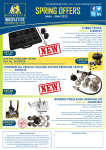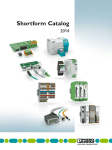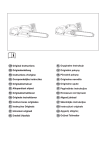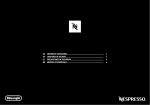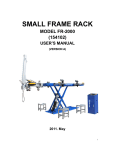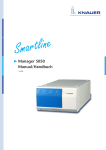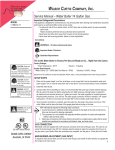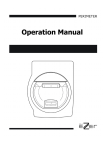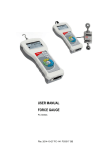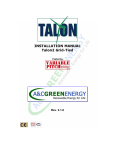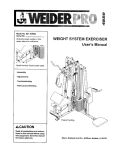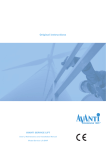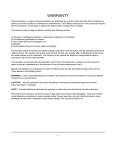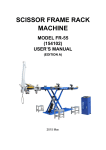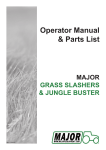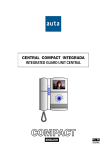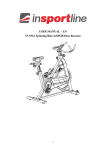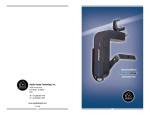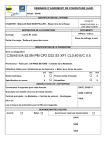Download Manual - Tuxedo Distributors
Transcript
18' Tilt, 2P10T-7.7K Frame Rack Machine MODEL FR-77 (154103) USER’S MANUAL (EDITION B) Mar. 2015 INTRODUCTION With the development of automobile design and manufacturing technology, more and more new materials are used on the body of the vehicle. Traditional vehicles are made by low or medium carbon steel, while modern unibody vehicles are made by high-strength steel. So the repair needs high technology and good equipments. When the vehicle is damaged, the repair workers should use pulling system to adjust it but not use fire if not necessary, because fire can change the structure of the metal and reduce the auto body’s strength. When the vehicle is crashed again, the body cannot protect the passengers as before. Our auto collision repairing systems uses the hydraulic pulling system and many kinds of accessories to pull the damaged parts into original. The measuring system will make the adjustment the same as the given data from the dimension manual. This manual is to talk about the installation, training, operation, and maintenance of Auto Collision Repairing System. It will tell the repairmen how to use this product and the accessories. During the installation and operation, the workers must do exactly as this manual says, or it will cause accidents and human’s injury. When the workers are operating the equipment, the pressure and load cannot surpass the required maximum pressure and load. FR-77 is especially designed for workers to do more quick adjustment and to better working experience. We give these equipment users more humane care by sensible design and configuration 1 CONTENT FR-77 18' Tilt, 2P10T-7.7K Frame Rack Machine INTRODUCTION ......................................................................................................................................... 1 CONTENT ..................................................................................................................................................... 2 Chapter 1 SAFETY CAUTIONS ................................................................................................................... 4 Chapter 2 SPECIFICATIONS ....................................................................................................................... 5 Chapter 3 COMPONENTS ............................................................................................................................ 6 Chapter 4 PACKAGE & TRANSPORT ...................................................................................................... 10 4.1 Package .................................................................................................................................................. 10 4.2 Loading .................................................................................................................................................. 10 4.3 Transport ................................................................................................................................................ 11 Chapter 5 INTRODUCTIONS .................................................................................................................... 12 5.1 Auto supporting system ......................................................................................................................... 12 5.2 Auto fixing system ................................................................................................................................. 12 5.3 Auto Pulling system ............................................................................................................................... 13 5.4 Hydraulic system ................................................................................................................................... 13 5.4.1 Hydraulic elements and flow chart ............................................................................................. 14 5.4.2 Hydraulic safety cautions ............................................................................................................ 14 5.5 Other tools...................................................................................................................................... 15 Chapter 6 INSTALLATION & OPERATION ............................................................................................. 16 6.1 Platform installation ............................................................................................................................... 16 6.1.1 Location requirement .................................................................................................................. 16 6.1.2 Fixing support installation .......................................................................................................... 16 6.1.3 Movable support installation....................................................................................................... 17 6.1.4 Locking bar installation .............................................................................................................. 17 6.1.5 Lifting support installation .......................................................................................................... 17 6.2 Pulling tower installation ....................................................................................................................... 19 6.2.1 Tower rolling system installation ................................................................................................ 19 6.2.2 Post guiding system installation.................................................................................................. 20 6.2.3 Collar installation ........................................................................................................................ 20 6.2.4 Cylinder, extend bar installation ................................................................................................. 21 6.2.5 Upper puller installation ............................................................................................................. 22 6.2.6 Install the post on the platform ................................................................................................... 23 6.3 Main clamps installation ........................................................................................................................ 24 6.4 Hydraulic system installation ................................................................................................................. 25 6.4.1 Safety caution ............................................................................................................................. 25 6.4.2 Installation ............................................................................................................................... 25 6.4.3 Maintenance ................................................................................................................................ 26 6.4.4 Hydraulic system specifications.................................................................................................. 26 2 6.4.5 Common problems of hydraulic system...................................................................................... 26 6.5 Accessories installation .......................................................................................................................... 28 6.5.1 Wheel trolley ............................................................................................................................... 28 6.5.2 Wheel support bracket................................................................................................................. 28 6.7 Loading and fixing the car ..................................................................................................................... 29 6.7.1 Loading ....................................................................................................................................... 29 6.7.2 Fixing the car .............................................................................................................................. 32 Chapter 7 AUTO BODY REPAIR DEMONSTRATION ............................................................................ 33 7.1 Auto body repair principle ..................................................................................................................... 33 7.2 Chassis repair technology ...................................................................................................................... 33 7.3 Collision repair process .......................................................................................................................... 33 7.4 Pulling process ....................................................................................................................................... 34 7.5.1 Auto front-end repair ................................................................................................................... 35 7.5.2 Auto back-end repair ................................................................................................................... 35 7.5.3 Auto side body repair .................................................................................................................. 36 7.5.4 Auto ceiling repair ....................................................................................................................... 36 7.6 Cautions during Auto repair ........................................................................................................... 36 Chapter 8 EQUIPMENT MAINTENANCE ................................................................................................ 38 Chapter 9 TROUBLE SHOOTING ............................................................................................................. 39 Chapter 10 END ........................................................................................................................................... 40 3 Chapter 1 SAFETY CAUTIONS Safety is the most important requirement. The workers should use the products very carefully. 1. Before repairing the damaged vehicle, the workers must refer to the service manual of the manufacturer’s manual, do as what the book says. 2. Before repairing, the workers must measure and analyze the damaged vehicle, then make adjustment process planning, and do according to it. 3. Before repairing the damaged vehicle, use the handbrake to avoid the movement of the vehicle. 4. When the platform is lifted or descended, pay attention to the tools, hydraulic tubes and air tubes, etc. it is forbidden to bake the hydraulic pump by fire. 5. Check the seal of hydraulic system often. 6. The workers who are not trained are forbidden strictly to operate the product. 7. Before pulling, the damaged vehicle must be clamped tightly. During the pulling, the vehicle is forbidden to move. 8. The pulling tools must be clamped tightly on the damaged parts, make sure that the pulling tools cannot come off during pulling. 9. During the pulling, it is forbidden to use jack to anchor the damaged vehicle, and the workers are forbidden to stand under the vehicle. 10. During the pulling, the pressure gauge of the hydraulic pump should not surpass 6000PSI. 11. The workers are forbidden to stand beside the vehicle when the vehicle is lifting. Some workers should help the driver to control the direction beside the platform when the vehicle is loading. The workers are forbidden to stand behind the stressed chain or pulling tools. 12. Before using the chain, check whether there are any bend, twist, knot, damaged parts, if there are, change the chain at once. The chain is forbidden to use bolt or bend to make it longer or shorter, if necessary, use the special tool (e.g. DC-G4120). It is forbidden to bake the chain by fire. 4 Chapter 2 SPECIFICATIONS Specifications: Bench Length 5500mm Bench Width 2100mm Bench Height 500mm Hydraulic pressure 70MPa Post Max. Tension 100KN Post Working Rang 360º Pneumatic Pressure Range 0.5~0.8MPa Max. Lifting Weight 3500Kg Total Weight 2450Kg 5 6 Platform bracket Fitting 7 13 Description 1 Code 9 2 Code Pipe Post Description 10 3 Code Pump ramp Description 11 5 Code Connector Clamp Description 12 6 Code connector Trolley Description Chapter 3 COMPONENTS 7 Code Description Code Description 1 Platform 1.13 Welded lower guide pipe 1.1 Platform assembly 1.14 Bolt M16X30 1.2 Fixed support assembly 1.15 Washer 16 1.3 Movable support assembly 1.16 Washer 20 1.4 Cylinder lower end joint 1.17 Nut M12 1.5 Welded lifting support 1.18 Spring Ф26.5xФ1.5x250 1.6 Cylinder upper end joint 1.19 Bead flange 26 1.7 Lifting support upper axle 1.20 Cylinder DC-1510* 1.8 Cylinder lower axle 1.21 WheelФ126xФ26x55 1.9 Lifting support lower axle 1.23 Throttle 1.10 Cylinder upper axle 1.24 M8X25 hexagon socket screw 1.11 Movable support axle 1.25 Spring Ф25xФ3x300 1.12 Welded locking bar Code Description Code 2.25 Description 2 Post components Bead flange 40 2.1 Post welded assembly 2.26 Tension bar welded assembly 2.2 Locking plate 2.27 Socket hexagon bolt M12X30 2.3 Locking assembly 2.28 Bearing 6205 2.4 Chain guider assembly 2.29 Bead flange 25 2.5 Hook plate 2.30 Socket hexagon bolt M10X25 2.6 Pump box 2.31 Extension head assembly 2.7 Traveling assembly 2.33 Upper puller head assembly 2.8 O cover 2.34 Nut M20 2.9 Traveling assembly axle 2.35 Washer 20 2.10 Chain guider manual bolt 2.36 Bolt M20X110 2.11 Chain guider pin 2.37 Upper puller 2.12 Bead flange 26 2.38 Nut M16 2.13 Extension assembly 2.39 Washer 16 2.14 Post cylinder 2.31 Extension head assembly 2.15 Cylinder basement 2.33 Upper puller head assembly 2.16 Socket hexagon bolt M8X25 2.34 Nut M20 2.17 Socket hexagon bolt M8X16 2.35 Washer 20 2.18 Bead flange 20 2.36 Bolt M20X110 2.19 Bolt M24X50 2.37 Upper puller 2.20 Nut M24 2.38 Nut M16 2.21 Bead flange 20 2.39 Washer 2.22 Spring 2.40 Bolt M16X110 2.23 Bearing basement 2.24 Bearing 6208 8 16 9 Chapter 4 PACKAGE & TRANSPORT 4.1 Package The equipment is packed with two lay of stretch film and one lay of corrugated paper. See Figure 4.1 Figure4.1 4.2 Loading If loading with the traveling crane, the loading capacity of the traveling crane should no less than 3T. In order to avoid incline, the cable sling should be tied at least 4 point at 4 corners of the platform. If loading with the fork lift, the lift arm should be over 2 meter, and the lifting capacity of the fork lift over 5T. The fork arm should goes into the platform from the long side. Keep the whole equipment in balance while loading or unloading. See Figure 4.2 10 Figure4.2 4.3 Transport FR-77 during transport, should chose large-tonnage truck, also should take the length and width into consideration according to the specifications of the equipment. The equipment should be well packed and fixed to the truck to prevent from water stain and bump. 11 Chapter 5 INTRODUCTIONS FR-77 auto chassis straightening machine can be used for auto loading, fixing, repairing and measuring. This chapter is meanly introducing the configuration and working theory. The detailed information about installation and operation will be particularly introduced in chapter 6. FR-77 series auto chassis straightening machine including: platform, fixed support, movable support, lift support. The auto supporting system is used to park the car on the platform, which is the operating table for damaged vehicles. See figure 5.1 5.1 Auto supporting system:Including Figure 5.1 5.2 Auto fixing system:Include Main clamp basement, clamp head, bolts and nuts. See figure 5.2 12 Figure 5.2 5.3 Auto Pulling system:Include tower, chains and some other components. Function: pull on the damaged part of the car. See figure 5.3 Figure 5.3 5.4 Hydraulic system:Include Hydraulic pumps, cylinders, oil gauge and oil tubes etc, provide power to the whole equipment. See figure 5.4 Figure 5.4 13 5.4.1 Hydraulic elements and flow chart FR-77 hydraulic system is simply included pneumatic pumps, connectors, oil tubes and oil gauge. See following oil circuit in figure 5.5. And flow chart under certain pressure in figure 5.6. Figure 5.5 Figure 5.6 5.4.2 Hydraulic safety cautions 1. High class cleaning standard should be carried out before installing the hydraulic system. The impurity in the oil will cause damage to the hydraulic system. 2. Check the oil tube before usage; make sure it is clean and well connected. 3. Check the cylinder and its components, leaking oil is forbidden. 4. Check the oil level in the pumps and charge up the oil in case of necessary. 5. Use PTFE tape to connect the oil tube and joints. 6. Vent the gas after connecting the hydraulic system. Other wise it will cause the cylinder shake or return. 7. Check the hydraulic system periodically. 14 5.5 Other tools:include wheel support bracket, car trolley, etc. See figure 5.7 Figure 5.7 15 Chapter 6 INSTALLATION & OPERATION 6.1 Platform installation 6.1.1 Location requirement Working area of the auto chassis straightening machine, see figure 6.1 Figure 6.1 6.1.2 Fixing support installation:Lift the platform over 500mm, install the fixed support with four bolts. See figure 6.2 Fig. 6.2 16 6.1.3 Movable support installation. Install the Movable support with two axes, remember o install the snap spring. See figure 6.3 Figure 6.3 6.1.4 Locking bar installation: Install all the components as the following figure shows, finally, fix the locking bar on to the movable support. Make sure the locking bar is easy to lock and unlocked. See figure 6.4 Figure 6.4 6.1.5 Lifting support installation: 1. Install two wheels onto the lifting support. See figure 6.5 17 2. Install the cylinder according to the Figure 6.6 shows. Figure 6.5 Figure 6.6 3. Install all the axes according to the figure 6.7, to install the lifting support on the platform. Finally, install all the springs. Figure 6.7 Caution: While installing No.3 axe, use the pump to push the cylinder pole out, then install the axe. 18 6.2 Pulling tower installation: 6.2.1 Tower rolling system installation:Install all the components according to the figure 6.8. Figure 6.8 Then install the traveling system on the post. See figure 6.9 Figure 6.9 19 6.2.2 Post guiding system installation:install according to the figure shows. See figure 6.10 Figure 6.10 Then install the guiding system on the post, install the last 4 bolts. See figure 6.11 Figure6.11 6.2.3 Collar installation:Firstly install the collar throw the top of the tower. See figure 6.12 Secondly, install the hand bolt, Sprocket wheel, axes onto the collar. See figure 6.13 20 Figure 6.12 Figure 6.13 6.2.4 Cylinder, extend bar installation:Firstly install the extending bar, cylinder, cylinder base and socket head screw according to the figure 6.14. Then hang the extending bar with a strong cable sling, put the whole cylinder assembly into the pulling tower. See figure 6.15. Finally install the direct connector and female connector onto the cylinder. See figure 6.16 Extend bar Cylinder Cylinder base M8×25 Screw Figure 6.14 Figure 6.15 21 Figure 6.16 6.2.5 Upper puller installation:FR-77 includes two pulling tower, one of them is equipped with upper puller system. Firstly install the top pole with upper puller. See figure 6.17. Install the upper puller onto the pole with one M20*120 bolt, then put the pole into the pulling tower. For the other kind of tower top pole, just put it into the tower. See Figure6.18 Figure 6.17 22 Figure 6.18 6.2.6 Install the post on the platform: Descend the platform, lift the post with crane or forklift, put the post travel wheel on the inferior plate of the platform, as the figure shows. Then pull out the guiding bar assembly out toward 1 position. Pull it out and let the bearing goes into the platform rail. Then install the hook plate. See Figure6.19 Figure 6.19 23 6.3 Main clamps installation FR77 includes single head main clamps. This clamp is a table vice model one and is easy to install. See figure 6.20 Main clamps Table vice model Figure 6.20 24 6.4 Hydraulic system installation 6.4.1 Safety caution A. Pay attention to the required pressure and bearing capacity. The working pressure cannot surpass the required pressure given on the gauge. B. Check the connectors. The connectors should be tightened with hands. C. Check the connectors of the oil tube. If it is seriously bent or broken, change it at once. D. The air pump should use water/oil separator. The workers should often empty the water and replace worn parts. 6.4.2 Installation A. Before working, check the connectors and oil tubes. B. Connect the oil tube with the lift cylinder under the platform. See figure 6.21 C. Connect the air pump to the air supplier. The required air pressure is 0.8Mpa. D. When operating the air pump, the gauge works. Use the air pump to control the tower pillar and platform. ATTENTION: The air pressure cannot surpass 6000PSI. E. Operate the pump slowly and the pressure outlet valve, make the pulling posts loosen slowly. Figure 6.21 25 6.4.3 Maintenance A. Check the joints and connectors regularly. The loosen connectors and oil leakage will make the hydraulic system work unstably. B. Check the hydraulic oil regularly. C. The hydraulic oil must be changed after working of 200-300 hours. If the working environment is dirty, the hydraulic oil must be changed after working of 35 hours. D. Keep the hydraulic parts from the pollution of dust and grease. E. Check the hydraulic oil after working of 40 hours every time. 6.4.4 Hydraulic system specifications A. Air pump PATG-1102N Power: 10000PSI Air supply required: 0.8Mpa B. Hydraulic cylinderRC1010: The longest travel: 10 inches Bearing capacity: 10T 6.4.5 Common problems of hydraulic system A. The unstable trouble of cylinder. If air mixed in the hydraulic system, it will work unsteadily. When the workers meet this problem, he can put the pump higher than the tube and the cylinder, this process will make the air inside go back to the oil reservoir. Turn off the valve. Repeat this process three to five times. B. The cylinder cannot last for the whole process. Usually not enough oil in the reservoir causes this problem. So the worker should check the reservoir. If needed, fulfill it with oil. C. The hydraulic cylinder cannot return. This problem is caused by too much air or oil. The worker should check the reservoir to keep reasonable oil inside. The worker should also check whether the bolt is bent or not and the 26 connectors are broken or not. D. The cylinder descends automatically when pressure is supplied. The worker should check whether the oil valve is turned off or not. If it is turned off and the cylinder still descends, check the ball valve of the oil and use alcohol or kerosene to wash it. If there is still trouble, repair the pump at once. E. The system only work for one time. Maybe the valve is dirty, wash it and add some oil. If the air pump, electric hydraulic pump, hydraulic cylinder, hydraulic pipe, gauge, etc. don’t work well, and if these parts are still in the period of repair warranty, they must be repaired by technician or the customer can send the bad tools to us, or to our named agents for repair. If the customer takes apart these parts without admission of us, furthermore, if there is any damage in the tools, the manufacturer has no responsibility for it. The customer must pay it by himself or herself. 27 6.5 Accessories installation 6.5.1 Wheel trolley Install according to the figure 6.22. 6.5.2 Wheel support bracket Install according to the figure 6.23. Figure 6.22 Figure 6.23 28 6.7 Loading and fixing the car 6.7.1 Loading A. Before loading the car, two post should be fixed at the fixed support end of the platform. See figure6.27 Figure 6.27 B. Connect the pneumatic pump with the air compressor (0.5-0.8Mpa), then connect the oil tube of the pump together with the lift support cylinder. Then operate the pump to up raise the platform till the movable support can swing freely. See figure 6.28 29 C. When the movable support left the ground, pull the locking bar out, swing the movable support. See figure6.29 Figure 6.28 Figure 6.29 D. Swing the movable support backward, until the locking bar lock the movable support in a declined degree. Then operate the pneumatic pump to let the platform descend onto the ground. See figure 6.30 Figure 6.30 E. Put the Drive-on ramp aside the descending end of the platform. Now move the car onto the platform with wheel trolley and hand wrench. If the wheels are removed, the wheel bracket is necessary. See figure 6.31. You may apply the tower to pull the car onto the platform. 30 Figure 6.31 F、Up raise the platform: 1. Check the equipment before raising the platform. Make sure the towers are locked, oil tube and air pipe is safe. 2. Locate the car wheel with wood, and park the car in neutral gear and brake with parking brake. 3. Operate the pneumatic pump to lift the platform. 4. Lock the movable support with locking bar. See figure 6.32 5. Operate the pneumatic pump to descend the platform, until the movable support reaches ground. Figure 6.32 31 Caution: The worker should not stand behind the car when lifting and descending the platform. The car should parked with neutral gear and brake with parking brake. During this operation, fixing the car with wood or chain is necessary. Operator should keep safety distance with the platform. When descending the platform, the pump should be loosen slowly, in case it descend too fast to cause human injury or property loss. Warning! Repairing the car without the movable support fixed is forbidden. 6.7.2 Fixing the car A. Check the chassis of the damaged car, make a best tightening scheme. B. Put the main clamp onto the platform, under the car chassis where can be snapped on. C. Lift the car with lifting accessories (rolling beam, air bag etc.) D. Rise the clamp head to a right height which can snap the edge of the car. Then loosen the bolt of the main clamps. E. Lift the car, put the clamps under the edge of the car. F. Tighten the bolt of the main clamps. G. Lock the clamp and the platform with the main clamp bolts. Tighten it with hook spanner. Caution! Tighten the bolt of the main clamps every time finish a pulling work. Check all the bolts to make sure the car will not slide when repairing. If the front tire is removed, the wheel should be fixed with wheel support bracket. 32 Chapter 7 AUTO BODY REPAIR DEMONSTRATION 7.1 Auto body repair principle If the damaged part is small, the worker can use pulling system to pull it out. But if there is a big damaged part or knot, the worker cannot repair it by pulling to the opposite direction. So collision repair needs the following tools: A. Clamp system B. Body repair tools C. Pulling system D. Measuring system 7.2 Chassis repair technology One direction pulling is suitable for frame body. It is easy for workers to repair and adjust the body. But it is not suit for unibody. The unibody is more complex, and the collision energy is easier to expand to the whole body. Most of the unibody repair needs several pulling. During the repair process, it needs more pulling points and directions. FR77 can fulfill the above requirements. It gives you a long list of repair accessories to avoid the construction damage for the vehicle. 7.3 Collision repair process A. The analysis of damaged body Before repairing, the worker should take off the damaged parts, for the collision energy is easy to manage far away. B. Pull After analysis, the worker should plan the repair process and do as it. C. The repair order The metal of unibody is easy to move and bend. So the worker should repair 33 the vehicle by different parts and direction. Or it may damage other normal parts. 7.4 Pulling process A. Length. Pull the damaged parts by the direction parallel to the centerline. B. Width. Pull the damaged parts by horizontal direction. C. Height adjustment. If some damaged parts are folded tightly, during the pulling, the worker should heat the damaged parts. The heated places can only be the edges or two tightened metal plates. Heating is a kind of way to relieve the stress but not a good way to soften any section. Pull the selected section to restore the original dimension slowly and relieve the stress of the bent steel. The damaged vehicle will be repaired correctly. For the reason of the unibody car is very sensitive to heat. So, never try to pull the car with once pulling stroke. Instead of that, the worker should pull the car –keep the strength-pull again- keep strength-pull again- keep strength. Etc. If the car folded very seriously after accident, there will be risks of metal break down. Now the worker needs to burn the metal. Only the connecting point and the two metal plates welded together point need burn. If burn the cross chassis of the car, this will make the damage even worse. Heating up can only be used as a way to avoid stress, not a way to soften the material that is very important. The order of repairing a car should be: length repairing, width repairing and height repairing. 34 7.5.1 Auto front-end repair The damage of the front section is decided by the crashing speed, inertia mass and damage position, etc. If the beam, bender and other accessories are damaged, the worker should pull the front beam on the side where the damaged parts should be changed. Sometimes, the collision energy will expand to the A pillars. The worker should take apart the front beam and bender and pull it, at the same time; the worker should push the damaged part from inside. DC-G1650 DC-G2450 DC-G0045 DC-G5622 DC-G4010 DC-G0750 DC-G0480 in usage . 7.5.2 Auto back-end repair The structure of rear section is more complex than the front section. The collision energy will expand easier. Usually the rear bumper. The fender will be damaged and cause the quarter panel to move to the front side, this will also changes the 35 gap of other parts. If it is possible, the damage will also influence the ceiling doors and body center pillar. When the workers use the pulling system to pull the damaged rear beam, floor or the rear hood. Then should measure the dimension under the body and decide the repair process according to the gap between the metals. Sometimes, the damage of front section will cause the twist. The worker should clamp the lower part of rear section. The basic adjustment can only adjust some lower parts. Then, install the clamp system again to keep the adjustment and go on the adjusting other damaged parts. Once the upper part can install the clamp system, the worker should install the clamp system at once and take off the serious damaged parts and install a new one. 7.5.3 Auto side body repair If the beside part of the vehicle is damaged. The floor will be changed also. To repair this kind of damage, the worker should pull the front and rear section firstly if they want to pull the damaged part from center section. If the worker wants to adjust the damaged part from the upper section, they should fix the bottom on the platform to the opposite direction. 7.5.4 Auto ceiling repair The damaged ceiling metal will cause the damage of the side pillar, bender and windshield. When the worker to repair the damaged part, they can use hydraulic ram to push from inside and use draw aligner to pull other parts. The operation of down pulling. 7.6 Cautions during Auto repair The basic rule of the collision repair is that: if the damaged part is impossible for adjustment, the repairman repairs the part to the original shape. During the adjustment, the worker can weld the damaged part when the bent edge become smooth or the cut welding part is moved to the back on the same line. When the 36 bent part becomes straight, the worker should use the hammer to relieve the stress. If it is a unibody, usually the parts depend on each other, so the damaged parts may be given more stress to the neighbor part. For this reason, the worker should pull it slowly and periodically, at the same time, check the movement of the parts, make sure the pull of the damaged place is effective. If the damaged part is not moved, the worker should change the pulling direction or pulling part. The pull strength is opposite to the damaged strength. So the damaged part is as strong as undamaged. The damaged parts all resist the pressure and there is a strong stress that destroys the pull. In fact, the adjustment and part changing cannot be done for the same time during the repair. So the worker has to measure the adjustment by eyes during the adjustment. If the adjustment is good, before going on the next adjustment, the worker has to finish every kind of repair. When it is the time to repair the close bent part, the worker can use the clamp pincers to clamp the bent part, then the adjustment direction is on the image line to the strength and this line is the prolong line of the original position. For the unibody, do not try to cut every part of the damaged part, and lately repair the part by welding another strengthened part. Because the modern design body construction is designed for the controlled damage, this can avoid delay the damage of the important part. So if the part is broken, torn or not well repaired, the worker should change the whole part. Usually the damaged part will meet the mort strong stress than neighbor part, so during the repair, all the important control pointer must be measured and controlled to avoid the excessive adjustment. 37 Chapter 8 EQUIPMENT MAINTENANCE 1. After using the equipment, clean the working place. 2. It is forbidden to put other goods on the bench rack. 3. Check the hydraulic oil regularly. 4. Change all of the oil if the hydraulic oil is bad. 5. The hydraulic cylinder and pump cannot overload for a long time. Or the leakage of the oil will damage the pump. 6. If the pump or the cylinder leaks oil, repair them at once. 7. The parts of hydraulic system and measuring system cannot be pressed when used. 8. Check the joints often, if necessary, put some grease on them. 9. Check the chains often, if they are damaged, change them at once. 38 Chapter 9 TROUBLE SHOOTING No. 1 Trouble Causation The pumps leaks oil or the oil tank plump up Treating The air intake valve of the pump locked Open the intake valve The quick connector is not tighten Tighten the quick connector The working sound of the pump is low, does not provide pressure, the pump room might mixed with gas Let out the gas, pressure to work and release at the same time, to let out the gas, operate like this 2~3 times, 2~3 minutes each time. The working sound of the pump is low, does not provide pressure, the oil intake of Open the oil tank and clean. Change the pump room and the oil tank might have hydraulic oil. The pump works but 2 dust inside. does not provide The working sound is normal, but pump pressure does not provide pressure. Might be caused by te lack of hydraulic oil in the oil Fill in with hydraulic oil tank. The working sound is normal, but pump does not provide pressure. The pump room might have air inside. Pressure to work and release at the same time, to let out the gas, operate like this 2~3 times, 2~3 minutes each time. If the pump still does not work, please call the seller of the pump as soon as possible. 3 4 The platform can not be lifted up The The same with the way of “Pump works Check the pump but no pressure” platform The 0.2mm hole of throttle valve is jammed descending very slow by impurity. Lock the post with the bolt first, then while at the corner of The post is not at the center of the position. push the post towards the platform. Lock the platform the locking plate. One of the traveling 6 wheels of the post goes astray. The 7 pressure gas. If still can not solve, change the throttle valve. Hard to lock the post 5 Clean the throttle valve with high head upper post 1.check the rail, if not smooth, repair it The travel speed of the post is too fast, or with sander. there is block on the rail. 2.push the post slowly, especially in the corner of the platform extension which puller, with a The head extension was jammed by the cannot post. Fill in the post with lubricating oil. And knock on the head extension with hammer. reposition. 39 Chapter 10 END This manual introduces the universal using method of T160, pictures and operating contents are for reference. The main processes of the collision repair include: the bent adjustment, reverse or change of the damaged welding steel panel. So the worker must have a whole repair plan when repairing the collision. And the main processes are as following: 1. Analyze the collision and make a plan 2. Dismount the decoration part and mechanical part. 3. Put the damaged vehicle on the bench rack, and decide to change or to repair the damaged part according to the actual condition. 4. Pull the damaged vehicle. 5. Rusty dealing. 6. Paint. 7. Restore all the dismounted parts. 8. Exercise the vehicle 40 The crash will influence the car very much. If the car is crashed, the body design will let the front and rear part to be easy damaged, because this steep will create an energy absorbing structure, and insure the safety of passenger seat. At that time, the worker should find the data, construction, direction, speed and the collision angle and direction, etc. before the right estimate, try best to learn about the fact and make a decision of the repairing plan. This manual talks about the installation and the use of the equipment, notice process, etc. and introduce clearly the collision analyzing. But for each damaged car, the worker should analyze the car and make a clear plan. 41











































